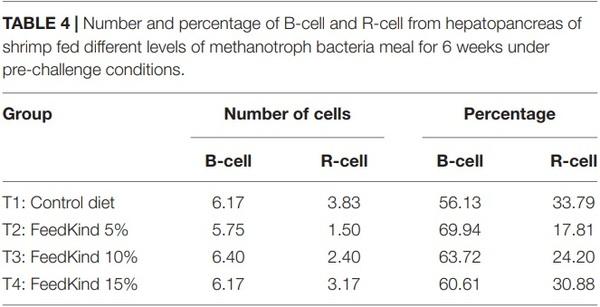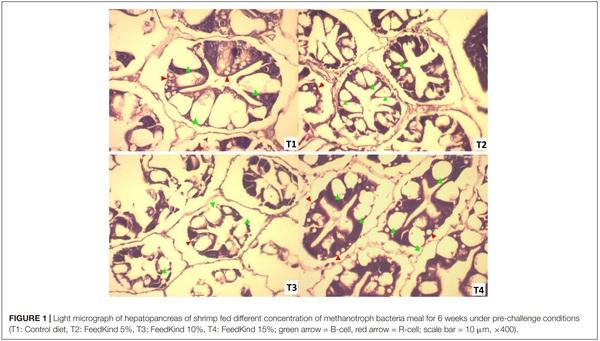Effects of a Single Cell Protein (Methylococcus capsulatus, Bath) in Pacific White Shrimp (Penaeus vannamei) Diet on Growth Performance, Survival Rate and Resistance to Vibrio parahaemolyticus, the Causative Agent of Acute Hepatopancreatic Necrosis Disease








Aas, T. S., Hatlen, B., Grisdale-Helland, B., Terjesen, B. F., Penn, M., BakkeMcKellep, A. M., et al. (2007). Feed intake, growth and nutrient utilization in Atlantic halibut (Hippoglossus hippoglossus) fed diets containing a bacterial protein meal. Aquac. Res. 38, 351–360. doi: 10.1111/j.1365-2109.2007.
01672.x
Anandaraja, R., Sridhar, R., Balachandran, C., Palanisammi, A., Ramesh, S., and Nagarajan, K. (2017). Pathogenicity profile of Vibrio parahaemolyticus in farmed pacific white shrimp, Penaeus vannamei. Fish Shellfish Immunol. 67,
368–381. doi: 10.1016/j.fsi.2017.06.020
Association of Official Analytical Chemists (AOAC) (2000). Official Methods of Analysis of AOAC International, 17th Edn. Gaithersburg, MD: AOAC
International.
Bell, T. A., and Lightner, D. V. (1988). A Handbook of Normal Penaeid Shrimp
Histology: World Aquaculture Society. Louisiana: World Aquaculture Society.
Berge, G. M., Baeverfjord, G., Skrede, A., and Storebakken, T. (2005). Bacterial protein grown on natural gas as protein source in diets for Atlantic salmon,
Salmo salar, in saltwater. Aquaculture 244, 233–240. doi: 10.1016/j.aquaculture.
2004.11.017
Biswas, A., Takakuwa, F., Yamada, S., Matsuda, A., Saville, R. M., LeBlanc, A., et al. (2020). Methanotroph (Methylococcus capsulatus, Bath) bacteria meal as an alternative protein source for Japanese yellowtail, Seriola quinqueradiata.
Aquaculture 529:735700. doi: 10.1016/j.aquaculture.2020.735700
Chen, M., Chen, X.-Q., Tian, L.-X., Liu, Y.-J., and Niu, J. (2020). Enhanced intestinal health, immune responses and ammonia resistance in Pacific white shrimp (Litopenaeus vannamei) fed dietary hydrolyzed yeast (Rhodotorula mucilaginosa) and Bacillus licheniformis. Aquac. Rep. 17:100385. doi: 10.1016/ j.aqrep.2020.100385
Chen, Y., Chi, S., Shuang, Z., Dong, X., Yang, Q., Liu, H., et al. (2021). Replacement of fishmeal with methane-utilizing bacteria products in the diets of Pacific white shrimp (Litopenaeus vannamei). Aquaculture 541:736801. doi: 10.1016/j. aquaculture.2021.736801
Chucherd, N. (2013). The case study of EMS in Thailand. Asian Aquac. Network
Pract. Maga. 4, 14–19.
Chumpol, S., Kantachote, D., Nitoda, T., and Kanzaki, H. (2018). Administration of purple non-sulfur bacteria as single cell protein by mixing with shrimp feed to enhance growth, immune response and survival in white shrimp (Litopenaeus vannamei) cultivation. Aquaculture 489, 85–95. doi: 10.1016/j.aquaculture.
2018.02.009
Díaz, A. C., Sousa, L. G., and Petriella, A. M. (2010). Functional cytology of the hepatopancreas of Palaemonetes argentines (Crustacea, Decapoda, Caridea) under osmotic stress. Brazilian Arch. Biol. Technol. 53, 599–608. doi: 10.1590/
S1516-89132010000300013
Dong, X., Wang, H., Xie, G., Zou, P., Guo, C., Liang, Y., et al. (2017). An isolate of Vibrio campbellii carrying the pirVP gene causes acute hepatopancreatic necrosis disease. Emerg. Microbes Infect. 6, 1–3. doi: 10.1038/emi.2016.131
Ekasari, J., Azhar, M. H., Surawidjaja, E. H., Nuryati, S., De Schryver, P., and
Bossier, P. (2014). Immune response and disease resistance of shrimp fed biofloc grown on different carbon sources. Fish Shellfish Immunol. 41, 332–339. doi:
10.1016/j.fsi.2014.09.004
Encarnacion, A. B., Fagutao, F., Jintasataporn, O., Worawattanamateekul, W.,
Hirono, I., and Ohshima, T. (2012). Application of ergothioneine-rich extract from an edible mushroom Flammulina velutipes for melanosis prevention in shrimp, Penaeus monodon and Litopenaeus vannamei. Food Res. Internatl. 45,
232–237. doi: 10.1016/j.foodres.2011.10.030
FAO (2018). The State of World Fisheries and Aquaculture 2018: Meeting the
Sustainable Development Goals. Italy: Food and Agriculture Organization of the
United Nations. 210.
FAO (2019). Report of the FAO Workshop on the on-Farm Feeding and Feed
Management in Aquaculture. Rome: Food and Agriculture Organization of the
United Nations., 8.
Fredrick, W. S., and Ravichandran, S. (2012). Hemolymph proteins in marine crustaceans. Asian Pac. J. Trop. Biomed. 2, 496–502. doi: 10.1016/S2221-
1691(12)60084-7
Gamboa-Delgado, J., Castañeda-Solís, J. D., Nieto-López, M. G., VillarrealCavazos, D., and Cruz-Suárez, L. E. (2014). Isotopic evaluation of the nutritional contribution of poultry by-product meal and fishmeal to the growth of pacific white shrimp, Litopenaeus vannamei. J. World Aquac. Soc. 45, 430–
438. doi: 10.1111/jwas.12134
Glencross, B. D., Huyben, D., and Schrama, J. W. (2020). The application of single-cell ingredients in aquaculture feeds—a review. Fishes 5:22. doi: 10.3390/ fishes5030022
Hamidoghli, A., Yun, H., Won, S., Kim, S., Farris, N. W., and Bai, S. C. (2019).
Evaluation of a single-cell protein as a dietary fishmeal substitute for whiteleg shrimp Litopenaeus vannamei. Fish. Sci. 85, 147–155. doi: 10.1007/s12562-018-
1275-5
He, W., Rahimnejad, S., Wang, L., Song, K., Lu, K., and Zhang, C. (2017). Effects of organic acids and essential oils blend on growth, gut microbiota, immune response and disease resistance of Pacific white shrimp (Litopenaeus vannamei) against Vibrio parahaemolyticus. Fish Shellfish Immunol. 70, 164–173. doi:
10.1016/j.fsi.2017.09.007
Hernández, C., Olvera-Novoa, M. A., Aguilar-Vejar, K., González-Rodríguez, B., and de la Parra, I. A. (2008). Partial replacement of fishmeal by porcine meat meal in practical diets for Pacific white shrimp (Litopenaeus vannamei).
Aquaculture 277, 244–250. doi: 10.1016/j.aquaculture.2008.02.016
Jones, S. W., Karpol, A., Friedman, S., Maru, B. T., and Tracy, B. P. (2020). Recent advances in single cell protein use as a feed ingredient in aquaculture. Curr. Opin. Biotechnol. 61, 189–197. doi: 10.1016/j.copbio.2019.
12.026
Joshi, J., Srisala, J., Troung, V. H., Chen, I., Nuangsaeng, B., Suthienkul, O., et al. (2014). Variation in Vibrio parahaemolyticus isolates from a single Thai shrimp farm experiencing an outbreak of acute hepatopancreatic necrosis disease (AHPND). Aquaculture 42, 297–302. doi: 10.1016/j.aquaculture.2014.03.030
Kondo, H., Van, P. T., Dang, L. T., and Hirono, I. (2015). Draft genome sequence of non-Vibrio parahaemolyticus acute hepatopancreatic necrosis disease strain
KC13.17.5, isolated from diseased shrimp in Vietnam. Genome Announcements
3:e978. doi: 10.1128/genomeA.00978-15
Lightner, D. V., Redman, R. M., Pantoja, C. R., Noble, B. L., and Loc, T. (2012).
Early mortality syndrome affects shrimp in Asia. Global Aquac. Adv. 2012:40.
Linder, T. (2019). Making the case for edible microorganisms as an integral part of a more sustainable and resilient food production system. Food Security 11,
265–278. doi: 10.1007/s12571-019-00912-3
Liu, L., Xiao, J., Xia, X., Pan, Y., Yan, S., and Wang, Y. (2015). Draft genome sequence of vibrio owensii strain SH-14, which causes shrimp acute hepatopancreatic necrosis disease. Genome Announcements 3:e1395. doi: 10.
1128/genomeA.01395-15
Liu, X., Steele, J. C., and Meng, X. Z. (2017). Usage, residue, and human health risk of antibiotics in Chinese aquaculture: a review. Environ. Poll. 223, 161–169. doi: 10.1016/j.envpol.2017.01.003
Malcorps, W., Kok, B., Land, M. V., Fritz, M., van Doren, D., Servin, K., et al. (2019). The sustainability conundrum of fishmeal substitution by plant ingredients in shrimp feeds. Sustainability 11:1212. doi: 10.3390/su11041212
Øverland, M., Borge, G. I., Vogt, G., Schøyen, H. F., and Skrede, A. (2011).
Oxidative stability and sensory quality of meat from broiler chickens fed a bacterial meal produced on natural gas. Poultry Sci. 90, 201–210. doi: 10.3382/ ps.2010-00784
Øverland, M., Romarheim, O. H., Hovin, M., Storebakken, T., and Skrede, A. (2006). Apparent total tract digestibility of unprocessed and extruded diets containing basic and autolyzed bacterial protein meal grown on natural gas in mink and rainbow trout. Animal Feed Sci. Technol. 129, 237–251. doi:
10.1016/j.anifeedsci.2005.12.017
Putth, S., and Polchana, J. (2016). “Current status and impact of early mortality syndrome (EMS)/acute hepatopancreatic necrosis disease (AHPND) and hepatopancreatic microsporidiosis (HPM) outbreaks on Thailand s shrimp farming,” in Addressing Acute Hepatopancreatic Necrosis Disease (AHPND) and Other Transboundary Diseases for Improved Aquatic Animal Health in
Southeast Asia: Proceedings of the ASEAN Regional Technical Consultation on
EMS/AHPND and Other Transboundary Diseases for Improved Aquatic Animal
Health in Southeast Asia, eds R. V. Pakingking Jr., E. G. T. de Jesus-Ayson and B. O. Acosta (Iloilo: Aquaculture Department, Southeast Asian Fisheries
Development Center), 79–87.
Qui, X., and Davis, D. A. (2017a). Effects of dietary phytase supplementation on growth performance and apparent digestibility coefficients of Pacific white shrimp Litopenaeus vannamei. Aquacu. Nutr. 23, 942–951.
Qui, X., and Davis, D. A. (2017b). Evaluation of flash dried yeast as a nutritional supplement in plant-based practical diets for Pacific white shrimp Litopenaeus vannamei. Aquac. Nutr. 23, 1244–1253. doi: 10.1111/anu.12499
Qui, X., Tian, H., and Davis, D. A. (2017). Evaluation of a high protein distiller’s dried grains product as a protein source in practical diets for Pacific white shrimp Litopenaeus vannamei. Aquaculture 480, 1–10. doi: 10.1016/j. aquaculture.2017.07.038
Samocha, T., Davis, D. A., Saoud, I. P., and DeBault, K. (2004). Substitution of fishmeal by co-extruded soybean poultry by-product meal in practical diets for the Pacific white shrimp, Litopenaeus vannamei. Aquaculture 231, 197–203. doi: 10.1016/j.aquaculture.2003.08.023
Shugar, D. (1952). The measurement of lysozyme activity and the ultra-violet inactivation of lysozyme. Biochim. Biophys. Acta. 8, 302–309. doi: 10.1016/
0006-3002(52)90045-0
Sokal, R. R., and Rohlf, F. J. (1995). Biometry: The Principles and Practice of Statistics in Biological Research, 3rd Edn. New York: W.H. Freeman and Co.
Soto-Rodriguez, S. A., Gomez-Gil, B., Lozano, R., del Rio-Rodríguez, R., Diéguez,
A. L., and Romalde, J. L. (2012). Virulence of vibrio harveyi responsible for the “bright-red” syndrome in the pacific white shrimp Litopenaeus vannamei.
J. Invertebr. Pathol. 109, 307–317. doi: 10.1016/j.jip.2012.01.006
Soto-Rodriguez, S. A., Gomez-Gil, B., Lozano-Olvera, R., Betancourt-Lozano,
M., and Morales-Covarrubias, M. S. (2015). Field and experimental evidence of Vibrio parahaemolyticus as the causative agent of acute hepatopancreatic necrosis disease of cultured shrimp (Litopenaeus vannamei) in Northwestern
Mexico. Appl. Environ. Microbiol. 81, 1689–1699. doi: 10.1128/AEM.03610-14
Swick, R. A., Akiyama, D. M., Boonyaratpalin, M., and Creswell, D. C. (1995).
Use of Soybean Meal and Synthetic Methionine in Shrimp Feed. St. Louis, MO:
American Soybean Association, Technical Bulletin, AQ43–AQ1995.
Tacon, A. G. J., Metian, M., and Hasan, M. R. (2009). Feed Ingredients and
Fertilizers for Farmed Aquatic Animals. Sources and Composition. FAO Fisheries and Aquaculture technical paper, 540. Italy: FAO.
Tan, B., Mai, K., Zheng, S., Zhou, Q., Liu, L., and Yu, Y. (2005). Replacement of fishmeal by meat and bone meal in practical diets for the white shrimp
Litopenaeus vannamei (Boone). Aquac. Res. 36, 439–444.
Thitamadee, S., Prachumwat, A., Srisala, J., Jaroenlak, P., Salachan, P. V.,
Sritunyalucksana, K., et al. (2016). Review of current disease threats for cultivated penaeid shrimp in Asia. Aquaculture 452, 69–87. doi: 10.1016/j. aquaculture.2015.10.028
Tlusty, M., Rhyne, A., Szczebak, J. T., Bourque, B., Bowen, J. L., Burr, G., et al. (2017). A transdisciplinary approach to the initial validation of a single cell protein as an alternative protein source for use in aquafeeds. PeerJ 5:e3170. doi: 10.7717/peerj.3170
Tran, L., Nunan, L., Redman, R. M., Mohney, L. L., Pantoja, C. R., Fitzsimmons,
K., et al. (2013). Determination of the infectious nature of the agent of acute hepatopancreatic necrosis syndrome affecting penaeid shrimp. Dis. Aquat. Orgs.
105, 45–55. doi: 10.3354/dao02621
Vogt, G. (2020). Cytopathology and immune response in the hepatopancreas of decapod crustaceans. Dis. Aquat. Orgs. 138, 41–88. doi: 10.3354/dao0
3443
Wu, C. C., Lin, C. L., Huang, C. Y., Hsieh, S., Liu, C. H., and Hsieh, S. L. (2019).
α-Phellandrene enhances the immune response and resistance against Vibrio alginolyticus in white shrimp (Litopenaeus vannamei). Fish Shellfish Immunol.
84, 1108–1114. doi: 10.1016/j.fsi.2018.11.013
Yang, Y. T., Chen, I. T., Lee, C. T., Chen, C. Y., Lin, S. S., Hor, L. I., et al. (2014). Draft genome sequences of four strains of Vibrio parahaemolyticus, three of which cause early mortality syndrome/acute hepatopancreatic necrosis disease in shrimp in China and Thailand. Genome Announcements 2:e816. doi: 10.1128/genomeA.00816-14
Zhan, W., He, L., Wei, X., Wang, X., and Tang, X. (2015) An antilipopolysaccharide factor in Litopenaeus vannamei participates in the immune defense against WSSV and Vibrio anguillarum. J. Crust. Biol. 35, 670–675. doi: 10.1163/1937240x-00002364
Zorriehzahra, M. J., and Banaederakhshan, R. (2015). Early mortality syndrome (EMS) as new emerging threat in shrimp industry. Adv. Anim. Vet. Sci. 3, 64–72. doi: 10.14737/journal.aavs/2015/3.2s.64.72
Conflict of Interest: AL and JS are employed by and own company stock in
Calysta, Inc., the supplier of the bacterial protein meal FeedKind used in these studies.
The remaining authors declare that the research was conducted in the absence of any commercial or financial relationships that could be construed as a potential conflict of interest.
Publisher’s Note: All claims expressed in this article are solely those of the authors and do not necessarily represent those of their affiliated organizations, or those of the publisher, the editors and the reviewers. Any product that may be evaluated in this article, or claim that may be made by its manufacturer, is not guaranteed or endorsed by the publisher.
Copyright © 2021 Jintasataporn, Chumkam, Triwutanon, LeBlanc and
Sawanboonchun. This is an open-access article distributed under the terms of the Creative Commons Attribution License (CC BY). The use, distribution or reproduction in other forums is permitted, provided the original author(s) and the copyright owner(s) are credited and that the original publication in this journal is cited, in accordance with accepted academic practice. No use, distribution or reproduction is permitted which does not comply with these terms.




.jpg&w=3840&q=75)